
This 8-minute video lesson looks at adding and subtracting rational expressions.
- Subject:
- Algebra
- Mathematics
- Numbers and Operations
- Material Type:
- Lecture
- Provider:
- Khan Academy
- Provider Set:
- Khan Academy
- Author:
- Salman Khan
- Date Added:
- 10/11/2012

This 8-minute video lesson looks at adding and subtracting rational expressions.
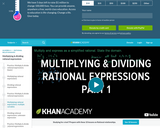
This 4-minute video lesson looks at multiplying and dividing rational expressions.
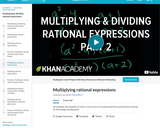
This 5-minute video lesson looks at multiplying and dividing rational expressions.

This 4-minute video lesson looks at multiplying and dividing rational expressions.

The Exponents and Radicals module is separated into two parts -- exponents and radicals. Each part has two subtopics. Each subtopic has a video lecture page and a practice assignment. The video lecture page includes guided notes in pdf form and videos that follow the guided notes. There are also Word document versions of the notes in the "files" section of this course for instructor convenience. Each video lecture page also includes supplemental YouTube videos which are optional for students and may be used if further instruction is needed. The practice assignment is a set of exercises in Derivita that correspond to the skills covered in the video lecture.There are also two review assignments in this module -- one for exponents and one for radicals. These assignments cover everything from that part of the module, rather than being broken up into parts like the practice assignments. So there are a total of six assignments in the module and instructors can choose which assignments are most appropriate for their students' needs.This work, by Madilyn Marshall, is licensed under a Creative Commons Attribution 4.0 International License.CC-BY

The Factoring module is separated into two parts -- factoring numbers and factoring algebraic expressions. Each part has subtopics. Each subtopic has a video lecture and a practice assignment. The video lecture page includes guided notes in pdf form and videos that follow the guided notes. Each video lecture page also includes supplemental YouTube videos which are optional for students and may be used if further instruction is needed. The practice assignment is a set of exercises in Derivita that correspond to the skills covered in the video lecture.This work, by Magdalene (Maxie) Inigo, is licensed under a Creative Commons Attribution 4.0 International License.Links to an external site.CC-BY

Short Description:
This textbook was created for the Pre-Health Sciences Pathway to Advanced Diplomas and Degrees program (PHS) program first term mathematics course. It is largely an adaptation of Elementary Algebra 2e by OpenStax
Long Description:
This textbook is intended for the Pre-Health Sciences Pathway to Advanced Diplomas and Degrees (PHS) program at Fanshawe College. It has been adapted using various math OERs and some original content by Fanshawe College. It is largely an adaptation of Elementary Algebra 2e by OpenStax. It presents six units of content covered in the first term (level 1) mathematics course in PHS.
Word Count: 214960
(Note: This resource's metadata has been created automatically by reformatting and/or combining the information that the author initially provided as part of a bulk import process.)
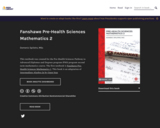
Short Description:
This textbook was created for the Pre-Health Sciences Pathway to Advanced Diplomas and Degrees program (PHS) program second term mathematics course. The first textbook is Fanshawe Pre-Health Sciences Mathematics 1. This book is an adaptation of Intermediate Algebra 2e by Open Stax
Long Description:
This textbook is intended for the Pre-Health Sciences Pathway to Advanced Diplomas and Degrees (PHS) program at Fanshawe College. It has been adapted using various math OERs and some original content by Fanshawe College. It presents six units of content covered in the second term (level 2) mathematics course in PHS.
Word Count: 132624
Included H5P activities: 42
(Note: This resource's metadata has been created automatically by reformatting and/or combining the information that the author initially provided as part of a bulk import process.)
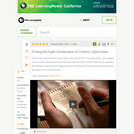
In this video segment from Cyberchase, Harry has a fixed budget for clothing, so he must figure out what combination of jackets and pants he can buy with $100.
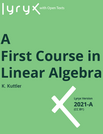
This text, originally by K. Kuttler, has been redesigned by the Lyryx editorial team as a first course in linear algebra for science and engineering students who have an understanding of basic algebra.
All major topics of linear algebra are available in detail, as well as proofs of important theorems. In addition, connections to topics covered in advanced courses are introduced. The text is designed in a modular fashion to maximize flexibility and facilitate adaptation to a given course outline and student profile.
Each chapter begins with a list of student learning outcomes, and examples and diagrams are given throughout the text to reinforce ideas and provide guidance on how to approach various problems. Suggested exercises are included at the end of each section, with selected answers at the end of the text.
Lyryx develops and supports open texts, with editorial services to adapt the text for each particular course. In addition, Lyryx provides content-specific formative online assessment, a wide variety of supplements, and in-house support available 7 days/week for both students and instructors.

This task is the second in a series of three tasks that use inequalities in the same context at increasing complexity in 6th grade, 7th grade and in HS algebra. Students write and solve inequalities, and represent the solutions graphically.

This task is the last in a series of three tasks that use inequalities in the same context at increasing complexity in 6th grade, 7th grade and in HS algebra. Students write and solve inequalities, and represent the solutions graphically. The progression of the content standards is 6.EE.8 to 7.EE.4 to A-REI.12.
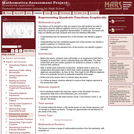
This lesson unit is intended to help teachers assess how well students are able to understand what the different algebraic forms of a quadratic function reveal about the properties of its graphical representation. In particular, the lesson will help teachers identify and help students who have the following difficulties: understanding how the factored form of the function can identify a graphŐs roots; understanding how the completed square form of the function can identify a graphŐs maximum or minimum point; and understanding how the standard form of the function can identify a graphŐs intercept.

Students learn about four forms of equations: direct variation, slope-intercept form, standard form and point-slope form. They graph and complete problem sets for each, converting from one form of equation to another, and learning the benefits and uses of each.
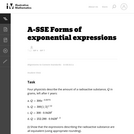
This task contrasts the usefulness of four equivalent expressions. Students first have to confirm that the given expressions for the radioactive substance are equivalent. Then they have to explain the significance of each expression in the context of the situation.

The Fraction module is separated into five pages. Each page except the first page has videos and lecture notes. At the end of the entire module are review problems. The review problems are a set of exercises in Derivita that correspond to the skills covered in the lecture pages and the videos.The instructors can choose to assign the practice problems based on their students' needs.This work was created by Kathryn Kozak, and it is licensed under a Creative Commons Attribution 4.0 International License.CC-BY
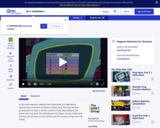
The CyberSquad tries to figure out how Hackerë_í__ cyberfrog moves when its various buttons are pressed, in this video from Cyberchase.

In this video from Cyberchase, the CyberSquad must figure out the new input/output pattern on Hackerë_í__ larger cyberfrog.
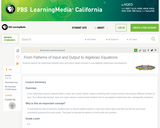
Students explore the relationship between input and output values and learn to use algebraic expressions and equations.

A cartoon about the proverbial mathematical "function machine".